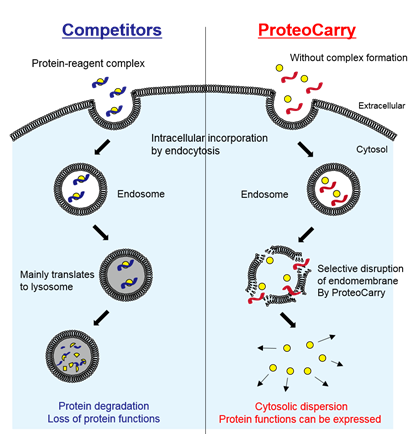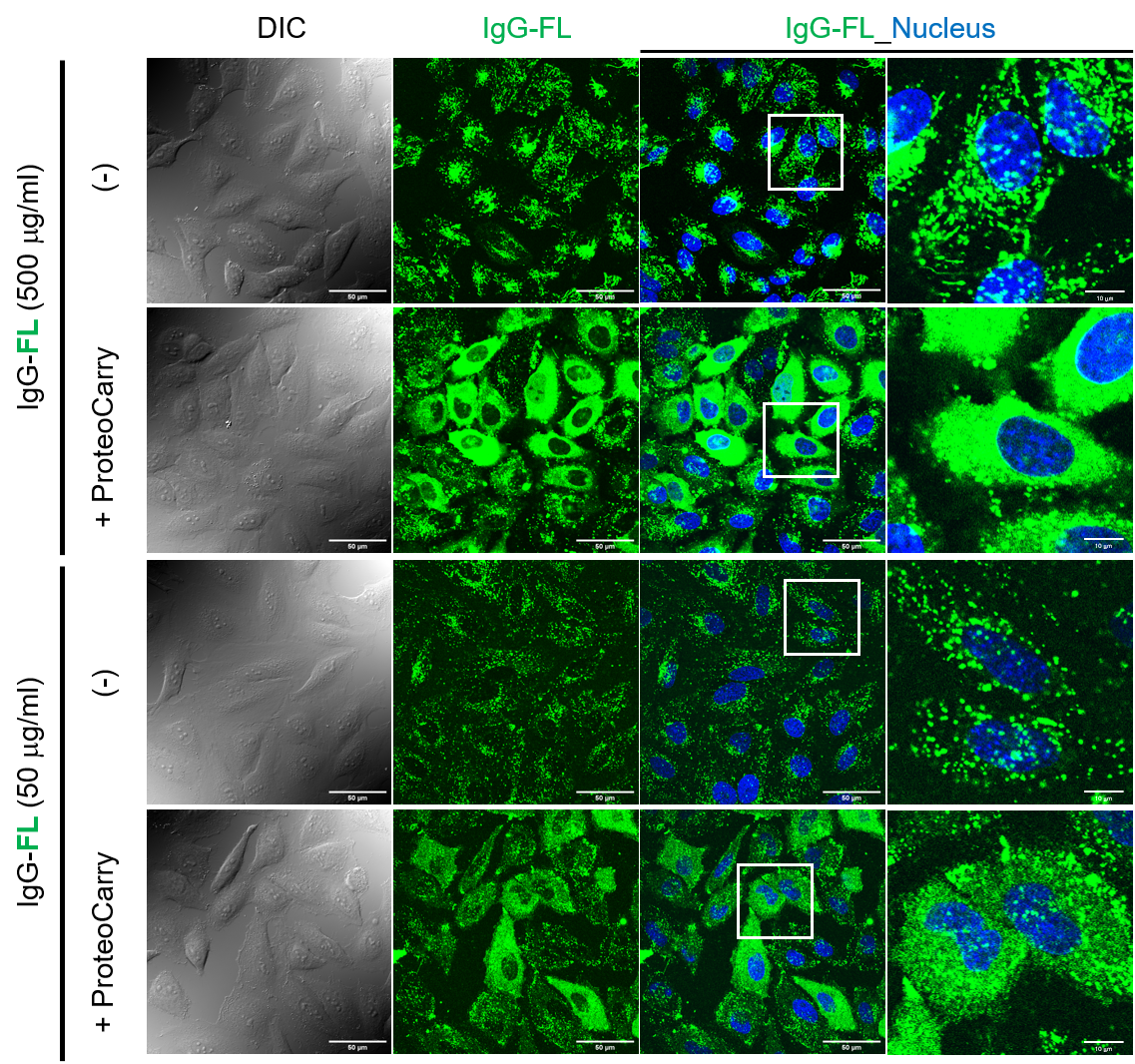Transfection Reagent for Delivering Target Proteins into Cytosol ProteoCarry™(Protein Transfection Reagent)
Date:November 28 2017Web Page No:80968

Funakoshi Co.,Ltd.
Going to Cytoplasm, not ending up in endosome!
This reagent introduces proteins and biological macromolecules (ex. dextran) into cells, especially cytosol. Conventional protein transfection reagents have been criticized for their retention in endosomes/lysosomes. However, this product can efficiently transport proteins into cytosol, and can be used in a wide range of experiments, such as evaluating the intracellular function of transfected proteins or inducing functional inhibition by introducing antibodies. In addition, unlike conventional reagents, this product does not require preincubation with proteins and does not form complexes, thus minimizing the impact on protein function.
- Background
- Features
- Procedure Overview
- Kit Contents
- Number of Assay
- Validated cell types
- Concentration Guideline
- Example of Use
- Product Information
Background
Features
- Peptide protein transfection reagent with high water solubility.
- It exhibits excellent endosomal membrane disruption activity and high cytoplasmic transmissibility compared to conventional methods. This peptide remains bound to endosomes even after endosomal membrane disruption. Please refer to ☞ the details.
- No pre-incubation with a transfectant is required, allowing easy and rapid transfection.
- Since it does not form a complex with proteins, a relatively high concentration of protein must be added, but the effect on protein function is minimized.
- One hour of treatment is sufficient for transfection into the cytoplasm.
- The transfection efficiency is not affected with or without serum (<10% FBS). It is possible to construct an experimental protocol tailored to the cells to be used.
- Various proteins and biomacromolecules have been transfected into cytosol.
Example: IgG antibodies, functional proteins (Cre recombinase, Saporin), polysaccharides (dextran) - There is little cytotoxicity at recommended concentrations.
Procedure Overview
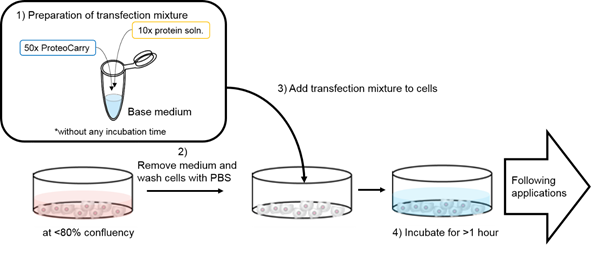
- Add this reagent and target proteins etc.(= transfection mixture) to fresh medium (serum-free, <10% serum-supplemented media or PBS).
※ Pre-incubation is not necessary. - After washing cells (<80% confluent state) with PBS twice, add the transfection mixture.
- Culture cells in the transfection mixture (>1 hour).
- Wash cells with PBS twice and add fresh medium.
- Cells can be used for following applications.
Kit Contents
- ProteoCarry™ (4 mg)
- FITC-dextran (2 mg, for positive control)
Number of Assay
| Size of well-plate | ProteoCarry™ | FITC-dextran |
|---|---|---|
| 6 well | 14 assays | 5 assays |
| 12 well | 28 assays | 10 assays |
| 24 well | 56 assays | 20 assays |
| 48 well | 140 assays | 50 assays |
| 96 well | 280 assays | 100 assays |
※ The above number of assays is an estimate based on the protocol described in the datasheet. It varies depending on the experimental method and conditions.
Validated cell types
- HeLa
- SW480
- COS7
- NIH3T3
- HUVEC
Concentration Guideline
| Transfectant | Final concentration for medium | |
|---|---|---|
| Antibody | 50-250 μg/mL | |
| Protein | Saporin | 1-10 μg/mL |
| Cre recombinase | 10-100 μg/mL | |
| FITC-dextran (positive control) |
200 μg/mL | |
※ The transfection efficiency changes depending on various factors such as cell type, cell number, and protein type. The above information is just a guide, and it is recommended to optimize each experiment.
Example of Use
Transfection of fluorophore-conjugated dextran
HeLa cells were treated with green fluorophore-conjugated dextran (Dextran-FL, average MW 10 kDa, final 200 μg/ml). When Dextran-FL alone was added to the cells (-), dot-like fluorescence signals were observed, but almost no fluorescence signal was observed in cytosol. On the other hand, when this product was used, fluorescence signals were observed throughout the cytosol, indicating that Dextran-FL was incorporated into the cytosol.
Transfection of fluorophore-conjugated IgG
HeLa cells were treated with green fluorophore-conjugated IgG (IgG-FL, final 50 or 500 μg/ml). When IgG-FLs alone were added to the cells (-), they were taken up by endocytosis and dot-like fluorescence signals were observed, which were found to be retained in endosomes and lysosomes. On the other hand, when this product was used, even if dot-like endosome structures were observed, fluorescent signals from cytosol were also observed, and it was understood that IgG-FLs diffused from endosomes into the cells.
※ When observing fluorescence signals in cytosol, signals in cytosol are diluted because cytosol is larger than endosomes. If the amount of transducers is small, the fluorescence originating from endosomes may be markedly observed even if the transducers diffuse into cytosol. To detect the fluorescence signal in cytosol, it is recommended to add relatively high concentration of fluorescent-labeled proteins.
Transfection of fluorophore-conjugated anti-nucleus pore complex
HeLa cells were treated with red fluorophore-conjugated anti-nucleus pore complex (NPC) antibody (anti-NPC-FL, final 50 μg/ml) in the presence or absence of ProteoCarry™ (1x conc.) for 1 hour at 37oC. Without ProteoCarry™ a little of fluorescent signal was observed in dot-like structure. On the other hand, ProteoCarry™ clearly promoted localization of anti-NPC-FL to peri-nuclear structure. This result indicates that ProteoCarry™ could induces incorporation of anti-NPC-FL into cytosol and binding of antibody to nucleus pore complex.
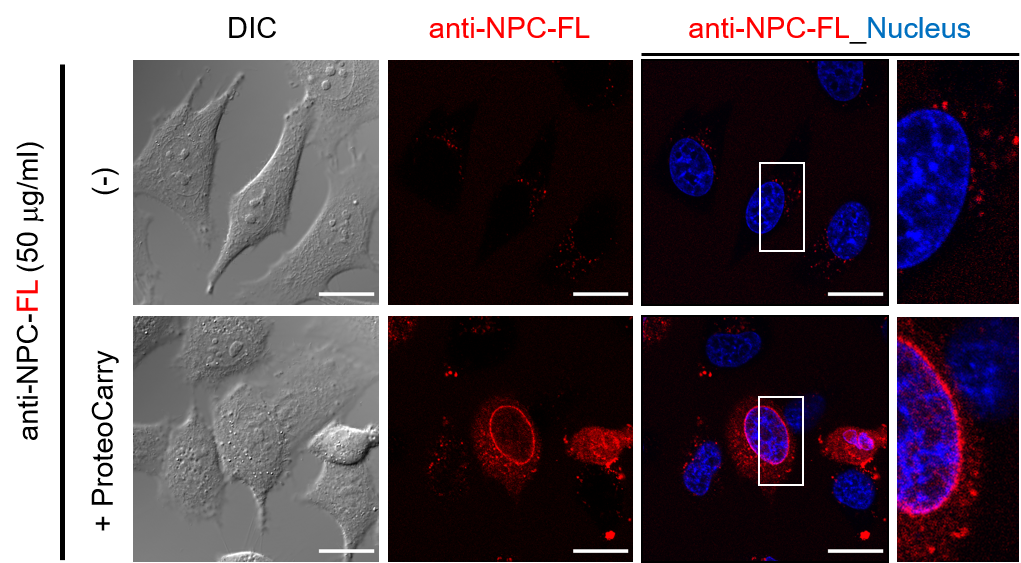
Transfection of nuclear-localizable EGFP
HeLa cells were treated with nuclear localization signal (NLS)-tagged EGFP (NLS-EGFP, final 10 μM) in the presence or absence of ProteoCarry™ (1x conc.) for 1 hour at 37oC. Without ProteoCarry™, a little of fluorescent signal was observed in endosome-like dot structures. On the other hand, ProteoCarry™ promoted nuclear-localization of NLS-EGFP.
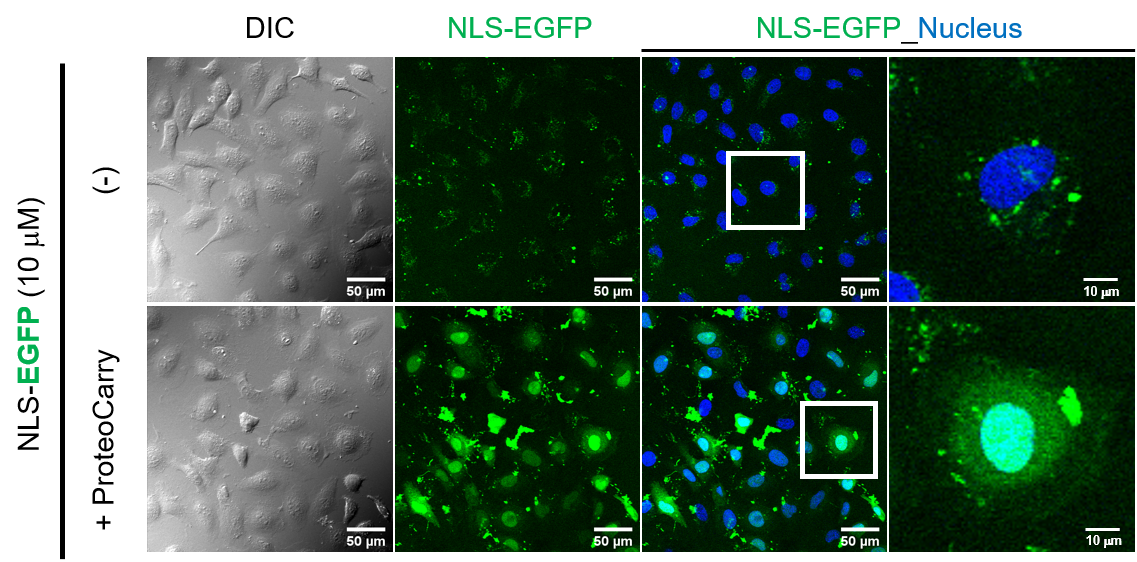
Transfection of Cre recombinase
HeLa cells were transfected with a plasmid which encodes loxP-DsRed-stop-loxP-EGFP sequence by conventional lipofection reagent. Next day, the HeLa cells were treated with recombinant Cre recombinase (final 10 μM) for 1 hour at 37oC with or without ProteoCarry™ (1x conc.). Without ProteoCarry™, almost cells still keep DsRed expression under the treatment of Cre recombinase. On the other hand, ProteoCarry™ promoted conversion from DsRed to EGFP by Cre/loxP recombination.

Transfection of Saporin enzyme
Saporin is an enzymatically cytotoxic protein which binds to ribosomes and inactivates ribosomes via its RNA glycosidase activity. RAW264.7 cells were treated with saporin (final 10 μg/ml) with or without ProteoCarry™ for 1 hour at 37oC. After 24 hours culture, cell viability was measured by MTT assay. Without ProteoCarry™, saporin induced cell death with less than 30% efficiency. On the other hand, ProteoCarry™ dramatically increased cytotoxicity of saporin and almost cells were dead (>90%).

Reference data: Intercellular localization of ProteoCarry™
To monitor intracellular localization of ProteoCarry™, fluorophore-labeled ProteoCarry™ (ProteoCarry™-FL) was prepared and HeLa cells were treated with ProteoCarry™-FL. Fluorescent signal was observed by confocal microscopy. Signal was detected mainly in endosomal dot like structure and little fluorescent signal was observed in cytosol. This data indicates ProteoCarry™ keeps binding to endosomal membrane after lysis of endosomes.
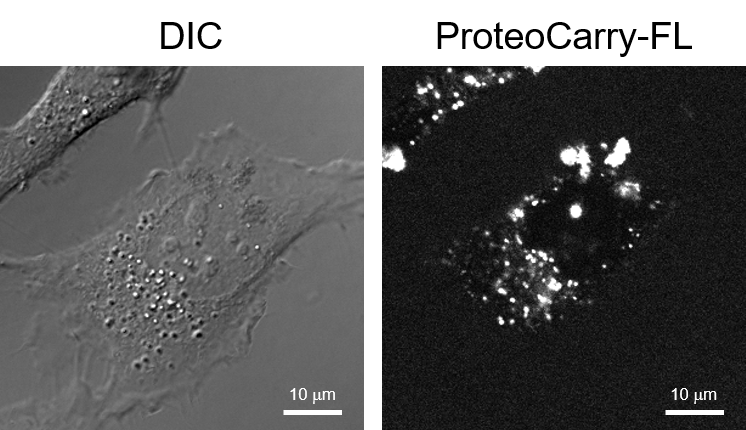
Product Information
[Date : December 27 2025 00:10]
| Detail | Product Name | Product Code | Supplier | Size | Price | ||||||||||||||||||||||||||||||
|---|---|---|---|---|---|---|---|---|---|---|---|---|---|---|---|---|---|---|---|---|---|---|---|---|---|---|---|---|---|---|---|---|---|---|---|
|
ProteoCarry, Protein Transfection Reagent DatasheetThis may not be the latest data sheet. |
FDV-0015 | FNAFunakoshi Co.,Ltd. | 1 set | $400 | |||||||||||||||||||||||||||||||
|
|
|
||||||||||||||||||||||||||||||||||
[Date : December 27 2025 00:10]
ProteoCarry, Protein Transfection Reagent
DatasheetThis may not be the latest data sheet.
- Product Code: FDV-0015
- Supplier: FNA
- Size: 1set
- Price: $400
| Description |
ProteoCarry is a novel peptide base transfection reagent which can avoid degradation of transfected proteins accumulated in endosomes or lysosome. It can deliver target proteins (enzyme, antibody, etc.) to cytosol efficiently by destroying the endosomal membrane because of the function of the new peptide base reagent. |
||
|---|---|---|---|
| Storage | -20°C | CAS | |
| Link |
|
||
CONTACT
export@funakoshi.co.jp
- ※Prices on our website are for your reference only. Please inquire your distributor for your prices.
- ※Please note that Product Information or Price may change without notice.

